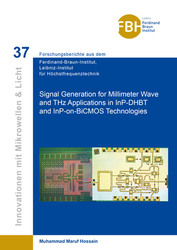| Areas | |
|---|---|
| Serie de libros (96) |
1377
|
| Nachhaltigkeit |
3
|
| Gesundheitswesen |
1
|
| Letra |
2361
|
| Ciencias Naturales |
5403
|
| Ciencias Ingeniería |
1788
|
| Ingeniería | 291 |
| Ingeniería mecánica y de proceso | 861 |
| Ingeniería eléctrica | 685 |
| Mineria y metalurgía | 30 |
| Arquitectura e ingeniería civil | 75 |
| General |
97
|
|
Leitlinien Unfallchirurgie
5. Auflage bestellen |
|
Erweiterte Suche
Signal Generation for Millimeter Wave and THZ Applications in InP-DHBT and InP-on-BiCMOS Technologies (Volumen 37) (Tienda española)
Muhammad Maruf Hossain (Autor)Previo
Indice, PDF (110 KB)
Lectura de prueba, PDF (180 KB)
A variety of commercial and defense applications are expected to have sub-terahertz (THz) and mm-wave integrated circuits in the near future. Silicon (Si) technologies partly meet the demands but are limited in their power handling capability. III-V technologies, in particular InP, offer higher output power but fall short of their Si counterparts if it comes to integration density and complexity. Thus, research on hetero-integration of Si with InP has gained increasing interest.
This work focuses on MMIC signal sources as important building blocks that are based on FBH’s 0.8 μm InP-DHBT transferred-substrate (TS) process, offering an InP-DHBT as well as an InP-on-BiCMOS version. This process is unique and provides interesting possibilities to realize integrated circuits in the frequency range between 100 GHz and more than 300 GHz. First, fundamental sources at 96 GHz and 197 GHz are presented. They deliver +9 dBm and 0 dBm output power with 25% and 0.5% overall DC-to-RF efficiency, respectively. Furthermore, 162 GHz and 270 GHz push-push sources are demonstrated utilizing an InP-on-BiCMOS process, which achieve -4.5 dBm and -9.5 dBm output power.
Subsequently, multiplier-based signal sources are demonstrated including a full G-band (140-220 GHz) frequency doubler, which delivers +8.2 dBm at 180 GHz and more than +5 dBm in the range 160-200 GHz. The doubler circuit exhibits a power efficiency of 16% in this frequency range. Also, the highest frequency is reached by a wideband 328 GHz quadrupler, with -7 dBm output power at 325 GHz and 0.5% DC-to-RF efficiency.
The final part is devoted to hetero-integrated circuits and the necessary design considerations. Two 250 GHz and 330 GHz sources are demonstrated that deliver -1.6 dBm and -12 dBm output power, respectively. These are the first hetero-integrated signal sources in this frequency range reported so far.
| ISBN-13 (Impresion) | 9783736993358 |
| ISBN-13 (E-Book) | 9783736983359 |
| Formato | A5 |
| Idioma | Inglés |
| Numero de paginas | 136 |
| Edicion | 1. Aufl. |
| Serie | Innovationen mit Mikrowellen und Licht. Forschungsberichte aus dem Ferdinand-Braun-Institut, Leibniz-Institut für Höchstfrequenztechnik |
| Volumen | 37 |
| Lugar de publicacion | Göttingen |
| Lugar de la disertacion | TU Berlin |
| Fecha de publicacion | 27.10.2016 |
| Clasificacion simple | Tesis doctoral |
| Area |
Telecomunicaciones e ingeniería de comunicaciones
|








